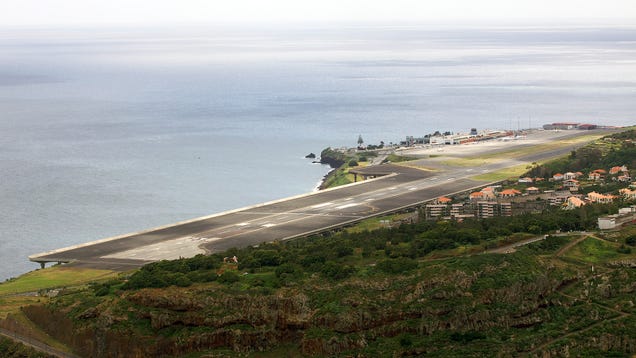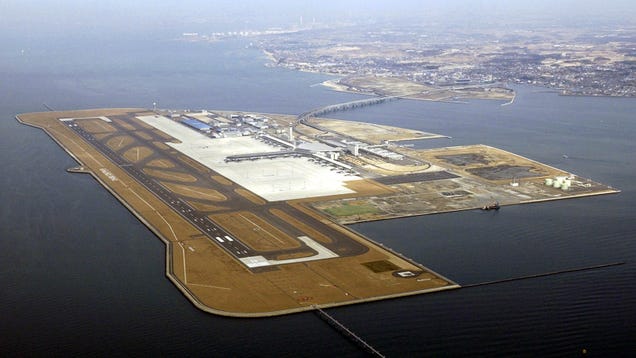
7 SUPER SCARY LANDING STRIPS
IN THE WORLD
001
TIOMAN ISLAND AIRPORT
TIOMAN ISLAND AIRPORT

Gunung Daik Bercabang Tiga is the local name for this remote spot, which you might have seen on film if you ever watched the movie ‘South Pacific’, for this was Bali Hai, in that film. A stunning, tropical island lying east from Malaysia and Kuala Lumpur. The airport here has a short runway, ending in a sheer drop over a cliff edge, and all pilots have to land heading straight for mountain range, before executing a 90 degree turn to line his plane up properly with the short runway. Landing here is truly terrifying.
002
COURCHEVAL AIRPORT, FRENCH ALPS
COURCHEVAL AIRPORT, FRENCH ALPS

A mere 1,722 feet of runway at this incredible airport, all of which is on undulating ground, ensures that both landings and seopecially take-offs are heart-stopping adrenaline rushes, the aircraft often plunging in the waiting abyss before the wings bite the air properly for flight, usually with what seems like only seconds to spare. Since the runway is often freezing, with heavy snow and back ice common problems, you can appreciate that landing here is hellish for all but the most experienced pilots. Not a destination for the faint-hearted.
003
SABA ISLAND AIRPORT, CARRIBEAN SEA

This miniscule landing strip, on the Caribbean island of Saba, in the Netherlands Antilles, is reputedly one of the most dangerous on earth, yet no accidents, to date anyway, have occurred there. With a runway even shorter than the one at Courcheval, at only 1,300ft, the Juancho E. Yrausquin Airport runway is simply too short for passenger jets, and being bordered by sea cliffs on three sides, while a mountain rears up on the fourth, it is small wonder that landing here is very tricky. Pilots can hardly afford to hesitate, however, because there is no aviation fuel to be had here. Not a landing strip to aim for if you are of a nervous disposition.
004
TENSING HILARY AIRPORT, LUKLA, NEPAL
TENSING HILARY AIRPORT, LUKLA, NEPAL


Named in honor of the first men to get to the top of Mount Everest, this airfield should get all those warning bells ringing out loud. Not only is it the highest operational runway in use today, at over 8,00oft up, but the airport has practically no modern air traffic features, no lights, and extremely limited availability of electric power. Take into consideration the daunting fact of a the runway sloping at a 12 degree angle, and you begin to comprehend why only the most experienced and daring will even attempt to take off or land there, and then only in daylight hours. Not sure I would want to take a chance on it, because this is one terrifying place to set down.
005
TONCONTIN AIRPORT, TEGUCIGALPA, HONDURAS
TONCONTIN AIRPORT, TEGUCIGALPA, HONDURAS

With a runway that is only 6,112 feet long, landings being made by any jet that is larger than a Boeing 757 are quite simply not possible, smaller jets that come in to land need to be piloted by very experienced and skilled men, as the shortness of the runway could be very problematic. Add to this the unfortunate fact of the airport location, surrounded on all sides by mountains, and sited in a deep valley which necessitates a steep approach by the aircraft, and you begin to appreciate how tough a task the pilots face. Not an airport to chance landing at, if you can avoid it.
006
GIBRALTAR AIRPORT, SPAIN
006
GIBRALTAR AIRPORT, SPAIN

Gibraltar is known as the Rock, and the small runway that serves it, seems to be getting crushed between the merciless Mediterranean and the immensity of Gibraltar itself. At only 6,000ft long, this short landing strip is bisected midway through by a main road, believe it or not, so railway level-crossing type barriers and sirens are on hand for when aircraft are on the tarmac. The weather around the strips also tends to be very temperamental, so planes can get severely buffeted on the way in or out. Another aircraft destination it might be wiser to think twice about.
007
MADIERA AIRPORT, FUNCHAL, CANARY ISLAND
MADIERA AIRPORT, FUNCHAL, CANARY ISLAND


With two landing strips a mere 5,250 feet in length, upon opening in 1964, Funchal was unable to accept larger aircraft. In 1977, a dreadful accident on landing saw Boeing 727 smashing a stone bridge on the way to stopping on the beach, and those in charge realized that longer runways were essential. They lengthened one by 655 ft, taking it up to almost 6,000, then In 2003 the extending it further, right over the beach in fact, supported on concrete 180 columns, each 230 ft high. Now long enough to accommodate the largest planes, the Madeira Airport approach run is still one of the most testing for pilots , because they have to initially aim the aircraft straight at a mountain peak, before turning sharply right to avoid crashing, while on a straight line for the runway. Since the extended landing strip ends abruptly, with a 300ft drop to the ocean below, overshooting the runway on landing would be a very bad mistake. Yet another landing that should set your pulses racing.
.
Direct copied from: green-buzz.net:

Paro Airport, Paro Dzngkha, Bhutan

Sea Ice Antartica

Chubu Centrair International, Tokoname, japan

Paro Airport, Paro Dzngkha, Bhutan

Sea Ice Antartica

Chubu Centrair International, Tokoname, japan
No comments:
Post a Comment